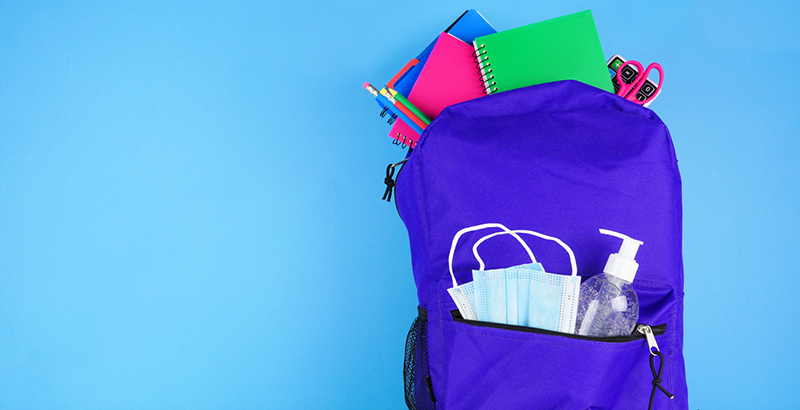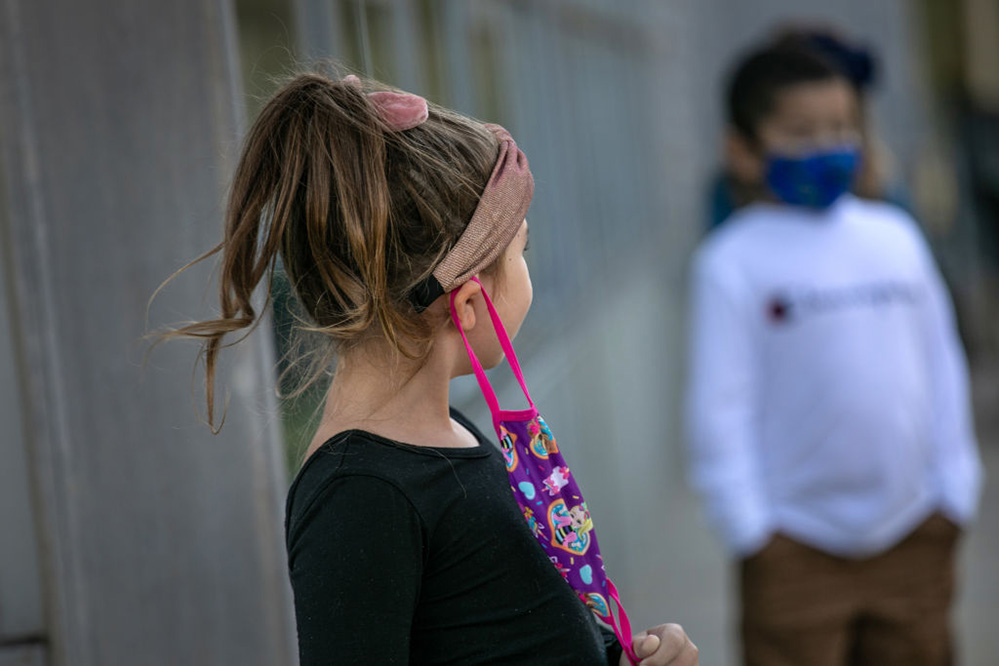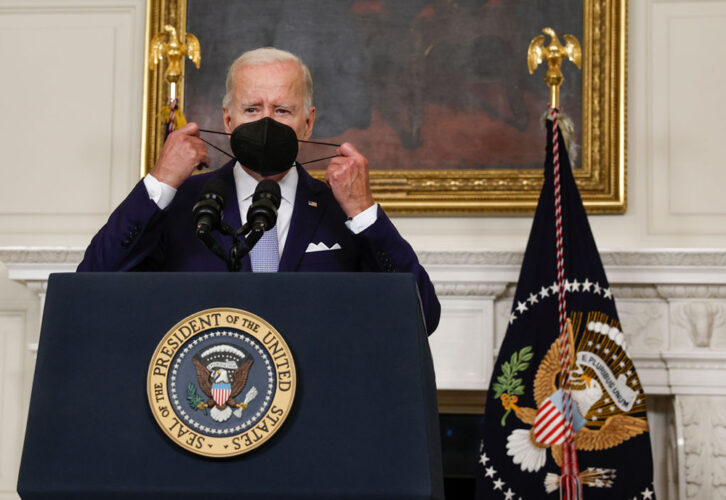CDC Eyes New School Rules on COVID Testing, Spacing, Quarantines
A weekly roundup of headlines about how the pandemic is shaping schools and education policy, vetted by AEI Visiting Fellow John Bailey

Get stories like this delivered straight to your inbox. Sign up for The 74 Newsletter
This is our weekly briefing on the pandemic, vetted by John Bailey. Click here to see the full archive.
This Week’s Top Story

CDC Expected to Ease COVID-19 Recommendations, Including for Schools
- Via CNN
- “A preview of the plans obtained by CNN shows that the updated recommendations are expected to ease quarantine recommendations for people exposed to the virus and de-emphasize 6 feet of social distancing.”
- “The agency is also expected to de-emphasize regular screening testing for COVID-19 in schools.”
- “As part of the expected changes, the CDC would also soon remove a recommendation that students exposed to COVID-19 take regular tests to stay in the classroom.”
- “The CDC is also set to ease quarantine requirements for people who are unvaccinated or who are not up to date on their COVID-19 vaccines. … Going forward, they won’t have to stay at home but should wear a mask and test at least five days after exposure.”
- “Sources say the tweaks reflect both shifting public sentiment toward the pandemic — many Americans have stopped wearing masks or social distancing — and a high level of underlying immunity in the population.”
Top Big Three
Education Groups Seek More Guidance on COVID Relief Spending
- Via K12 Dive
- “The organizations, which include AASA, The School Superintendent Association, and the Council of Chief State School Officers, said more guidance is urgently needed as school systems make spending decisions for the three pockets of funding that comprise [the Elementary and Secondary School Emergency Relief Fund].”
- “As stewards of taxpayer dollars, we want to make sure that we’re making the wisest investments possible,” said Sasha Pudelski, AASA’s director of advocacy.
Biden COVID Case Highlights Confusing CDC Guidance on Ending Isolation

- Via the Washington Post
- “More than 2½ years into the pandemic, and with a highly contagious version of the virus circulating, the CDC guidelines for what to do when falling ill — and when to return to public life — continue to stoke as much confusion as clarity. That’s a reflection of the changing nature of the virus, the inherent unpredictability of an infection, and the demands and expectations of work and home life.”
- “With new research showing that people are often infectious for more than five days, the CDC guidance has drawn criticism from some infectious-disease experts.”
- “ ‘Given that a substantial portion of people do have a rapid positive test after five days, I think an updated recommendation should include people having a negative rapid test before coming out of isolation for COVID,’ said Tom Inglesby, director of the Johns Hopkins Center for Health Security, who was the Biden administration’s senior adviser on testing from December until April.”
Despite Progress, a Third of Students Finished Year Below Grade Level
- The 74 reports on new Institute of Education Sciences School Pulse survey data.
- “Public school leaders estimated that nearly half of their students (50%) began the 2021-22 school year behind grade level in at least one academic subject, which is 14 points higher than the percentage of students they estimated to be behind grade level in at least one academic subject at the beginning of a typical school year before the pandemic began (36%).”
- “Public school leaders estimated that just over one-third of their students (36%) ended the 2021-22 school year behind grade level in at least one academic subject.”
Federal Updates
Good Jobs Challenge
- The Department of Commerce announced grants to 32 industry-led workforce training partnerships across the country as part of the $500 million Good Jobs Challenge.
- The Economic Development Administration also announced an award of a $4.6 million grant to Jobs for the Future to coordinate and lead a national Community of Practice dedicated to sharing best practices, providing technical assistance and extending professional networks among the challenge’s grantee organizations.
Biden Administration Unveils Long-COVID Reports
- The Department of Health and Human Services released two reports, one on a research action plan and the other on federal services and support for people with long COVID.
City & State News
Washington, D.C.
- Schools expand COVID vaccine mandate, unlike most other districts.
- “Overall, about 85% of students between the ages of 12 and 15 have been vaccinated against the virus, but the rate drops to 60% among Black children in this age range.”
California
Hawaii
- Hundreds of classrooms are found with poor ventilation, posing a COVID-19 risk.
Kansas
- More than 21,000 homes and businesses are set to receive high-speed internet access for the first time, thanks to an $83.5 million grant program through the state Department of Commerce’s Office of Broadband Development.
COVID-19 Research
Heart Disease After COVID
- Via Nature
- “Some studies suggest that the risk of cardiovascular problems, such as a heart attack or stroke, remains high even many months after a SARS-CoV-2 infection clears up. Researchers are starting to pin down the frequency of these issues and what is causing the damage.”
Kids Might Help Shield Adults from Severe COVID-19
- Study
- “In a large, real-world population, exposure to young children was strongly associated with less severe COVID-19 illness, after balancing known COVID-19 risk factors. This epidemiologic signal suggests endemic coronavirus cross-immunity may play a role in protection against severe COVID-19 outcomes.”
- “However, adults without exposure to children had lower rates of COVID-19 infection but significantly higher rates of COVID-19 hospitalization and hospitalization requiring ICU admission compared to those with children aged 0-5.”
- UPI: ” ‘One hypothesis that people batted around was maybe people that had a lot of common colds in the past few years may have some built-up immunity to cope with COVID-19, and then either not get an infection at all or get only a mild infection and not a severe one,’ said lead researcher Dr. Matthew Solomon, a cardiologist.”
- “This study can’t prove that having a common cold protects you from severe COVID-19, only that it may confer some immunity. But the research team said the concept merits further exploration.”
Paxlovid Appears to Be Reaching the Americans Who Need It Least
- Via The Economist
- The “drug may not be reaching those who need it most. The counties prescribing Paxlovid the most tend to have high vaccination rates and few comorbidities, such as diabetes. On average, people in these areas are unusually likely to survive COVID even without Paxlovid’s help.”
- “Paxlovid is rare in counties that have low vaccination rates, and where many are poor and unhealthy. People with COVID in these areas may be less likely to seek out and obtain the drug when it is effective, during the first five days of illness.”
Viewpoints and Analysis
L.A. Unified Estimates Up to 20,000 Students Are Not Enrolled
- Via L.A. Times: “Two weeks before school starts, Los Angeles Unified Superintendent Alberto M. Carvalho estimates that between 10,000 and 20,000 students are not enrolled or stopped attending last year, with the problem most pronounced in the youngest grades.”
- “The district also is scrambling to fill about 900 classroom teaching positions and to find more than 200 bus drivers.”
- “The district is also confronting a worsening daily attendance problem. Data in March 2022 showed that nearly half of LAUSD students — more than 200,000 children — were chronically absent during the last school year.”
- “Much of the absenteeism was related to COVID-19 quarantines and infections. In the coming year, there will be no at-home quarantines for close contacts without symptoms, although students and staff will have to remain masked during the quarantine period.”
What Goes Wrong When Some School Board Members Don’t Understand District Finances?
- Via Marguerite Roza
- “For now, temporary federal aid is delaying much of the fallout from imbalanced budgets. But relief funds last only until September 2024, at which point these decisions will make it difficult for many districts to pay their bills. When budgets get out of whack, districts tend to burn through their reserves, eliminate school days and make sharp reductions in staff, programs and services. Some will see their credit ratings suffer or be subject to state takeover. The resulting financial instability can last decades.”
‘Never Seen It This Bad’: A Teacher Shortage Looms
- America faces catastrophic teacher shortage, the Washington Post reports.
- “The Nevada State Education Association estimated that roughly 3,000 teaching jobs remained unfilled across the state’s 17 school districts as of early August. In a January report, the Illinois Association of Regional School Superintendents found that 88% of school districts statewide were having ‘problems with teacher shortages’ — while 2,040 teacher openings were either empty or filled with a ‘less than qualified’ hire. And in the Houston area, the largest five school districts are all reporting that between 200 and 1,000 teaching positions remain open.”
As Fewer Kids Enroll, Big Cities Face a Small Schools Crisis
- Via Chalkbeat
- “More than 1 in 5 New York City elementary schools had fewer than 300 students last school year. In Los Angeles, that figure was over 1 in 4. In Chicago it has grown to nearly 1 in 3, and in Boston it’s approaching 1 in 2, according to a Chalkbeat/AP analysis.”
- “Many districts like Chicago give schools money for each student. That means small schools sometimes struggle to pay for fixed costs — the principal, a counselor and building upkeep.”
- “To address that, many allocate extra money to small schools, diverting dollars from larger schools. In Chicago, the district spends an average of $19,000 annually per student at small high schools, while students at larger ones get $10,000, according to the Chalkbeat/AP analysis.”
Some K-12 Systems Thrived During COVID-19. What Made Them So Prepared?
- Via Phyllis Lockett
- “It turns out that three key factors helped these schools respond effectively to pandemic-related disruptions: 1) self-directed, forward-leaning orientation for students and adults; 2) healthy cultures; and 3) strong yet flexible systems.”
- “More importantly, the schools had made a commitment to these strategies before COVID-19, giving them a strong foundation for dealing with remote learning and other challenges.”
…And on a Lighter Note
It’s Difficult to Get Work Done: When the interns are so needy.
For even more COVID policy and education news, subscribe to John Bailey’s daily briefing via Substack.
Disclosure: John Bailey is an adviser to the Walton Family Foundation, which provides financial support to The 74.
Get stories like these delivered straight to your inbox. Sign up for The 74 Newsletter

;)
